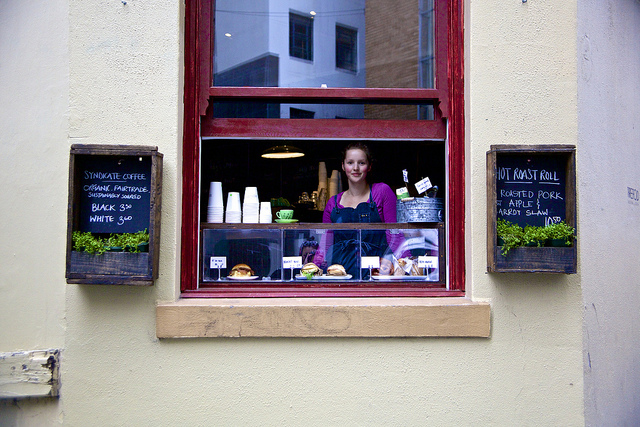Unlock the Magic in Your Story Now
Get the Free 20 questions to Ask Before Launching Your Idea workbook when you sign up for occasional updates.
Get the Free 20 questions to Ask Before Launching Your Idea workbook when you sign up for occasional updates.
Articles filed in: Storytelling
The Value Of Fixing The Root Of The Problem
filed in Storytelling, Strategy
 The first step to fixing any problem is to acknowledge there is one.
The first step to fixing any problem is to acknowledge there is one.
If you find yourself starting every email with ‘sorry’, question why you’re constantly doing that.
If the software doesn’t work the first time, every time, dig deeper before you need to use it again.
If your projects always run over budget look for patterns that reveal the holes in your estimates.
If deadlines consistently allude you be honest about what you need to do to change that.
The simplest way to create exponential value is to make promises you intend to keep and then to keep them. You know from experience hardly anyone does this. Promises are often hastily made and casually broken. Find a way to be the exception and not the rule.
Image by Tobias Toft.
How To Stay True To Your Brand Story
filed in Storytelling, Strategy
 You can spot the best restaurant on Melbourne’s Bourke Street a mile away. It’s the one with fresh flowers on the tables outside and the gleaming windows. If you’re there early enough, you’ll see a professional window cleaner meticulously washing and polishing the glass every other morning, long before the first groggy coffee order is placed at 7.
You can spot the best restaurant on Melbourne’s Bourke Street a mile away. It’s the one with fresh flowers on the tables outside and the gleaming windows. If you’re there early enough, you’ll see a professional window cleaner meticulously washing and polishing the glass every other morning, long before the first groggy coffee order is placed at 7.
Story-driven brands pass every decision and subsequent action through a filter. Their story is lived, not just told. Being story-driven is less about following brand guidelines and more about choosing to act in alignment. We’ve recently witnessed how a company’s purpose and values manifest in the actions of its employees when a passenger was dragged from a United Airlines flight to accommodate members of staff. United’s customer commitment (the company doesn’t seem to have a mission statement) says:
“We are committed to providing a level of service to our customers that makes us a leader in the airline industry. We understand that to do this, we need to have a product we are proud of and employees who like coming to work every day.”
When a business strives to be ‘the industry leader’ the bottom line tends to be its first priority. The staff were acting in alignment, as was the CEO when he issued this apology that puts the airline’s interests before customers:
“This is an upsetting event to all of us here at United. I apologize for having to re-accommodate these customers. Our team is moving with a sense of urgency to work with the authorities and conduct our own detailed review of what happened. We are also reaching out to this passenger to talk directly to him and further address and resolve this situation.”
– Oscar Munoz, CEO, United Airlines
He later released a second apology, promising to review policies and procedures—which in every organisation are created to align with the company’s purpose, vision and values. Like Mr Munoz and United, we all need to start there.
How you apologise is a choice. The expression you wear as you greet the customer is a choice. Where you source your ingredients is a choice. What you include or omit from your terms and conditions is a choice. Investment in design. Location. Customer care and spotless windows.
All choices we’re free to make—not because we have to, but because we want to.
Questioning your choices before you act helps you to stay true to your story consistently.
4 Alignment Questions For Story-Driven Brands
Does this represent who and what we stand for?
Does this sound like us?
Does this look like us?
Does this feel like us?
Rather than feeling overwhelmed about getting it wrong consider these decisions as deliberately placed waymarkers on the road to creating the impact you want to make. It doesn’t matter whether you’re one of the world’s biggest airlines or a one man band. In the end, it’s easier to tell and live a story that’s true.
Image by Michelle Robinson.
Two Essential Characteristics Of Story-Driven Brands
filed in Storytelling, Strategy
 You’ve probably had a disappointing experience with a brand or business. Maybe you couldn’t put your finger on what was wrong or why? Customer dissatisfaction is a result of a gap between promises and actions. Filthy bathrooms at the restaurant with the elaborately embossed menu. The snappy flight attendant who wears a painted on smile. Uncomfortable plastic seats in the chiropractor’s waiting room. Out of date produce on sale in the organic grocery store. A damaged delivery that was carelessly packaged.
You’ve probably had a disappointing experience with a brand or business. Maybe you couldn’t put your finger on what was wrong or why? Customer dissatisfaction is a result of a gap between promises and actions. Filthy bathrooms at the restaurant with the elaborately embossed menu. The snappy flight attendant who wears a painted on smile. Uncomfortable plastic seats in the chiropractor’s waiting room. Out of date produce on sale in the organic grocery store. A damaged delivery that was carelessly packaged.
People often ask me about the secret of a great brand story. I think there are two. Truth and consistency. It’s hard to live one without the other. When our brands are story-driven, that story is lived in every single decision, consistently, on good days and bad. The delight is in the detail.
Image by Dukas Ju.
The Secret To Being Exceptional
filed in Storytelling, Success
 You might remember when you were a high school student (as I do) trying to work out a revision system that helped you to maximise your chances of academic success. I never had much luck. Teachers held up model students as examples of how ‘hard work’ paid off. Straight-A students it seemed were the ones who did ‘the most’ work. And ‘most’, being infinite was a daunting place to start.
You might remember when you were a high school student (as I do) trying to work out a revision system that helped you to maximise your chances of academic success. I never had much luck. Teachers held up model students as examples of how ‘hard work’ paid off. Straight-A students it seemed were the ones who did ‘the most’ work. And ‘most’, being infinite was a daunting place to start.
It’s taken me a good thirty years to realise that exceptional performance is not a result of expending the most effort—trying to reach the summit in a single, spectacular leap. The secret to being exceptional is in the small choices we make moment-to-moment. The student who organises his notes from the very first lecture of the first semester. The hotel receptionist who consciously makes every interaction meaningful. The athlete who pushes through the last three uncomfortable reps. The CEO who intentionally seeks out and acts on the wisdom of his team. The doctor who greets her patients warmly by shaking them by the hand. Ordinary people making small choices that incrementally make them exceptional.
Small, deliberate choices, made moment-to-moment, have a huge impact over time—not just on the work we do and the people we serve, but on our belief about what’s possible. It’s easy to fall into the trap of complaining about the things beyond our control we can’t change. If we want to be exceptional, we need to get into the habit of finding reasons why we must, instead of making excuses why we can’t.
Image by Louis Vest.
The Power Of Expectations
filed in Marketing, Storytelling
 The packaging on the flat-pack garden shed promised fast, easy assembly (80% faster than the competitor’s product), using 75% fewer screws, pre-drilled holes and a 30-year warranty. Taking the manufacturer at their word the customer’s expectation is set. The shed takes two people five hours to assemble, requires additional drilling, a trip to the hardware store to buy a special riveting tool and leaves the weary handymen with a bag of fifty extra screws and abandoned Sunday afternoon plans. There’s a clear mismatch between the expectation the company set and the reality the customer experienced.
The packaging on the flat-pack garden shed promised fast, easy assembly (80% faster than the competitor’s product), using 75% fewer screws, pre-drilled holes and a 30-year warranty. Taking the manufacturer at their word the customer’s expectation is set. The shed takes two people five hours to assemble, requires additional drilling, a trip to the hardware store to buy a special riveting tool and leaves the weary handymen with a bag of fifty extra screws and abandoned Sunday afternoon plans. There’s a clear mismatch between the expectation the company set and the reality the customer experienced.
Dissatisfied customers are not just created by products and services that don’t work. Dissatisfaction is also a direct result of the stories we the marketers lead customers to believe. Expectations once set are hard to shift. Our words have the power to change so much more than the customer’s decision to click the buy button. We should use them wisely.
Image by Melody Hansen.
Why You Need To Build A Story-Driven Business
filed in Storytelling, Strategy
 What drives our desire to get better at telling the story of our products, services and companies? We’re used to thinking of story as a way to create and communicate value. We know the running shoe with a tick on the side is more valuable than the one without because of the expectations and meaning we have attached to the story of the Nike brand. And who doesn’t want their company to be more meaningful and valuable?
What drives our desire to get better at telling the story of our products, services and companies? We’re used to thinking of story as a way to create and communicate value. We know the running shoe with a tick on the side is more valuable than the one without because of the expectations and meaning we have attached to the story of the Nike brand. And who doesn’t want their company to be more meaningful and valuable?
What we really want from our story, though, goes beyond the need to be better known, sell more stuff or make more money. We are yearning for a deeper understanding of what we’re here to do and the difference it might be possible to create. The story, not of what is, but what’s at stake and what could be is what drives our desire to succeed.
The most inspired entrepreneurs and successful organisations know how important and powerful understanding the significance of your story can be. What drives Elon Musk, for example, is not building more cars for the sake of selling more cars. Tesla Motors and SolarCity (the energy company Musk is Chairman of) exist to ‘accelerate the advent of sustainable energy’.
If someone were to ask you to tell them the story of your business you’d likely explain what you make, who you serve, where and how long you’ve been doing it. It’s unlikely you’d begin by telling them why any of it matters in the grand scheme of things (even though it does). What’s at the heart of your story? What’s the reason you got out of bed this morning? It isn’t just pride in the product you made, the need to launch the website you coded or the hope of selling the service you designed. It’s the deep desire to change someone or something you care about changing and the belief that it’s possible.
The intended impact of your work on the world and in the lives of the people it touches is where your story begins.
Elon Musk knows what he’s setting out to do over the next ten years because he and his companies are built on a story-driven business framework. Their vision of a sustainable energy economy which helps to avert the collapse of civilisation is the reason they are setting out to;
‘Create stunning solar roofs with integrated battery storage, expand the electric vehicle product line to address all major segments, develop a self-driving capability that is 10X safer than manual and enable your car to make money for you when you aren’t using it.’
THE STORY-DRIVEN BUSINESS FRAMEWORK
1. PURPOSE: Why we exist.
2. VISION: Where we’re headed.
3. VALUES: The beliefs that guide us on that journey.
4. PLAN: How we will deliver on the vision while staying true to our values.
When your business or organisation is story-driven, it’s grounded in a framework of purpose, vision and values that inspire commitment, create momentum and lead to a solid plan for achieving success. This enables you to adapt in times of change because you understand that your story is bigger than the scene that’s playing out in the moment.
What’s driving your story?
Image by NRMA
You WILL Have Unhappy Customers
filed in Storytelling, Strategy
 Unhappy customers are a bit of an Achilles heel of the committed entrepreneur, business owner or leader. When you’re working hard to build a business and do meaningful work the last thing you want to hear is that you haven’t met the mark. You can find thousands of practical, stay calm, listen, sympathise, don’t take it personally and solve the problem type articles and advice online. But skillfully dealing with the complaint isn’t the hard part. The more challenging thing to cope with and attend to is our visceral reaction to criticism.
Unhappy customers are a bit of an Achilles heel of the committed entrepreneur, business owner or leader. When you’re working hard to build a business and do meaningful work the last thing you want to hear is that you haven’t met the mark. You can find thousands of practical, stay calm, listen, sympathise, don’t take it personally and solve the problem type articles and advice online. But skillfully dealing with the complaint isn’t the hard part. The more challenging thing to cope with and attend to is our visceral reaction to criticism.
The unhappy customer lays his story at our feet, and we hastily pick it up, place it on our shoulders and carry it around with us. Yes, sometimes our products or services fall short, sometimes we get it wrong even when we’re doing our best. We should always apologise for failing to meet expectations and do what we can to resolve the problem. What we must also do is recognise that often the customer’s fear, anger, remorse or disappointment has less to do with a bad experience and more to do with what’s going on in his life right now.
You WILL have unhappy customers, no matter how caring and diligent you are. There is no way to avoid the pain of this fact. That one in a hundred customer who calls you out is the price you pay for the privilege of getting up to do the work again another day.
So yes, take responsibility for your mistakes and fix the things you can fix—while remembering there are some things you have no way of making good. You are not obliged to own the weight of your customer’s circumstances or worldview. You have an obligation to get back on track for the other ninety-nine customers you hope to serve and delight. Some of the greatest lessons unhappy customers can teach us are not about improving systems, processes and logistics, which in the end are easily fixed. The important learnings are about ourselves, and our resilience and determination to do good work and make a difference to the people we get the chance to serve again tomorrow and the day after that.
Image by FFCU.
Why You Need An If-Then Storytelling Strategy
filed in Storytelling, Strategy
 It was a slow Thursday evening at the iconic sportswear store. There were more sales assistants than customers silently wandering through the displays across polished black tiles. Alan decided to approach a customer who had just picked up a premium shoe, turning it over to check out the price.
It was a slow Thursday evening at the iconic sportswear store. There were more sales assistants than customers silently wandering through the displays across polished black tiles. Alan decided to approach a customer who had just picked up a premium shoe, turning it over to check out the price.
‘Can I help you?’ he said.
‘No, I’m just looking, thanks.’ she replied.
‘It would be good to get out of those Nikes. Have your tried our SuperBOOST shoes?’ said Alan.
‘No.’ said the customer, as she hastily put the shoe back.
‘They’re really comfortable and last longer.’ Alan said to the customer as she started to walk away.
We would never say half of the things we say or ask many of the questions we ask if we stopped for a second to think how the customer was likely to respond. What if instead of following a script that leads us to a dead end, we anticipated where our questions would lead the customer? We know that 99% of the time the response to, ‘Can I help you?’, will be, ‘No.’ So how can we do better?
An if-then storytelling strategy invites us to be more empathetic towards the customer and more discerning with our questions.
If the customer is browsing for more than a few minutes, then I will ask how I can help.
If the customer is looking at running shoes, then I will ask her what kind of training she does.
If the customer picks up an item, then I will ask her if she’d like to try her size.
If the customer asks for her size, then I will try getting to know more about what she needs from her shoes.
Better brand stories, marketing and sales conversations always start with understanding what unmet need or unspoken desire brought the customer to us, rather than with our need to say something when it’s convenient.
Image by Amira A.
The Right Words
filed in Marketing, Storytelling
 When we have a message to communicate, we obsess over finding the right words. Which copy will convert better? How can we construct the perfect offer that draws people in?
When we have a message to communicate, we obsess over finding the right words. Which copy will convert better? How can we construct the perfect offer that draws people in?
What we lose in our attempt to optimise the words is the ability to create a deeper more lasting connection with the reader, user or customer. We forget that we’re not just in the business of trying to win a sale today, but that we’re aiming to build a relationship that sustains both the people we hope to serve and ourselves.
Yesterday a note arrived in the letterbox from our wonderful local council. They’re resurfacing the road and repairing the pavement on our street next week, and of course, there will be disruptions. The note addressed to owner/occupier, goes straight into the project details, time frame, parking and access. It ends with a warning that vehicles parked will be towed and an apology for any inconvenience caused. What a missed opportunity not simply to inform, but to deepen connections with people in the community.
The whole tone of the message could be flipped on its head by positioning as something to celebrate.
‘We’re delighted to let you know we’re starting work on improving your street next week. No more potholes! Obviously, this will mean some disruption and inconvenience for a few days, but we hope you’ll think it’s worth it when you cycle down the brand spanking new road. Here’s what you need to know and how you can help.’
What we say might get people’s attention, but how we say it changes not only what they think, but how they feel and act. It’s worth considering how you want people to feel after they’ve read or heard your message, not just about what you want them to do next.
Image by Hans Splinter.
The Shortcut To The Sale
filed in Marketing, Storytelling
 Yesterday I watched a woman squirm as she was being upsold two post-treatment skincare products priced at $300 by her beauty therapist. Think about the context here. She’d just spent an hour with the therapist, giving her permission to ask questions others can’t ask and allowing her to touch parts of her others never see. The client’s vulnerability is laid bare in a treatment room. This is a high trust situation. The therapist leaves her to dress and then meets her outside waiting to take payment—this is when the switch happens.
Yesterday I watched a woman squirm as she was being upsold two post-treatment skincare products priced at $300 by her beauty therapist. Think about the context here. She’d just spent an hour with the therapist, giving her permission to ask questions others can’t ask and allowing her to touch parts of her others never see. The client’s vulnerability is laid bare in a treatment room. This is a high trust situation. The therapist leaves her to dress and then meets her outside waiting to take payment—this is when the switch happens.
“These are the two post-treatment creams I want you to use. They will accelerate the results of your treatment today.” the therapist says, sliding two sleek boxes, minus price tags across the counter towards the client. It’s embarrassing to ask the price of the creams or to admit she’s not sure she wants them, especially when they are positioned as required and not optional. Yes, the therapist had permission, she earned the privilege to speak to the customer—then she promptly went and abused it, betraying all the trust she had worked so hard to obtain.
Even us marketers sometimes find marketing slightly distasteful because we know we’re not always doing things that are in the customer’s best interests—things we’re not proud to have done. We know in our heart of hearts when we’re treating people in ways we would find disingenuous, irritating or embarrassing if the shoe were on the other foot. And yet we take the shortcut to the sale instead of the long way round to mattering.
Like the two-sided coin, every moment is an opportunity to choose the right thing over the easy thing. If you’re reading this I know which one you’re shooting for.
Image by Mislav Marohnić.